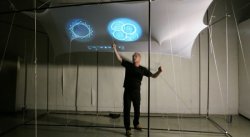Faculty Spotlight: Karl Nussbaum
Posted in: School of Communication and Media News

In his play, "Back to Methuselah," George Bernard Shaw wrote, "You see things; and you say, ‘Why?’ But I dream things that never were; and I say, ‘Why not?" When you talk to School of Communication and Media film Professor Karl Nussbaum, you have to conclude Shaw’s comment is Nussbaum’s spiritual driving force. A piece of ripped fabric seen by Nussbaum in Malta becomes a metaphor for the eye looking up to heaven. A bed becomes a screen for an image of our inevitable deterioration and death. The audience is pulled in and made co-author as they are invited to bring their own life experiences to the installation.
You get the sense Karl Nussbaum is not just an ordinary filmmaker. He is in fact an artist. After many years of working as an experimental filmmaker and screening at various film festivals, he has shifted his practice away from the strategies and traditions of film into video installation and video performance. He has expanded the traditional perception of the medium that carries the story. To Nussbaum, the screen is no longer flat; it’s three dimensional, the shape of the screen is no longer rectangular. In fact, there may be no sides at all, or the shapes can change as the images change. It can be a fluttering silk screen, a parachute, a bed, a lampshade, a glass of milk. It takes the old McLuhanism, "the medium is the message," to new heights. While the traditional screen was simply a conveyance for the story, to Karl, the medium (ie: the projection surface) is an integral part of the story. Medium and message are one. Stories are no longer bound by linear thinking; they’re circular or even oblique.
Instead of filming for the screen, Karl has reversed the shooting process, and it is the screen and its specific qualities of movement, placement or shape that influence what is being filmed. His work has most recently been influenced by the 18th century French Phantasmagoria and the film magicians orchestrating them. A prime example is Charles-Emile Reynaud – the French father of animation and his Theatre Optique which created a live film experience in turn of the century Paris.
The spiritual side of Karl Nussbaum’s work is an exploration of ideas about transformation, memory, family, trauma and the experiences of death and grief. It’s the continuum of life – continuity, connectivity and closure as evidenced in his newest video performance piece, ‘Topology‘:
With a background in biology, Nussbaum often includes elements of science and the natural world as spiritual metaphor, transforming scientific ideas into visual and lyrical forms. Nowhere is this more in evidence than in his work "Hilbert Space" (2011, 10 min.), a single channel video performance that is an homage to his mathematician father, A. Edward Nussbaum. Hilbert Space was his father’s specialty and refers to a type of conceptual mathematics named after the famous German mathematician David Hilbert.
Like many of his works, the piece seeks to cast a spell over the audience. Images are projected onto a large silk screen suspended overhead. During the performance the screen is manipulated by the performer using cables, making the screen rise and flutter as the images float and distort above the audience. It’s all meticulously choreographed and Nussbaum even becomes part of the narrative as he steps onto a small platform and casts his shadow into the imagery.
